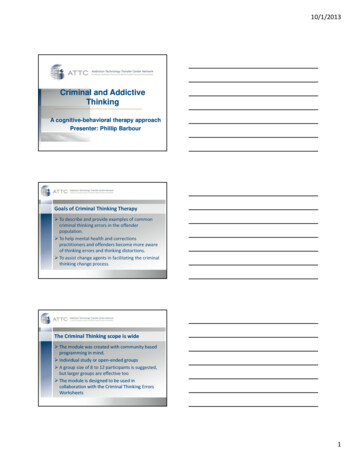
Transcription
RESEARCH FUND SERIESSystems thinking:How is it used in project management?Association for Project ManagementApril 2018
2
AcknowledgementsThis work was supported by the Association for Project Management (APM) Research Fund.The Research Fund has been set up within the wider APM Research programme to providefunding for small-scale research projects, or seed funding for larger projects seeking toaddress key issues that are either directly involved in, or related to, the management ofprojects, programmes and portfolios. For more information, please e authors are grateful for the support of Wellingtone Project Management foradministering the survey and sharing its results, and also for the time given up byinterviewees and by respondents to the survey.AuthorsDr Michael Emes MEng PhD CEng MIET MAPM MINCOSE, University College LondonWilliam Griffiths, MSc student, University College LondonAPM research sponsorDaniel Nicholls – APM research managerAbstractSystems thinking is not a new technique for project management, but neither itsapplication, nor understanding of its benefits, is widespread. Interviews and two surveyshave been conducted to explore the use of systems thinking in project management.We find that the majority of respondents believe that project managers use some formof systems thinking at least half of the time, but many recognised systems thinking toolslike rich pictures and soft systems methodology are not widely used in projects. Use ofsystems thinking tools is slightly greater for more experienced project managers, and forthose working in sectors that deliver complex technological products such as defence andaerospace. Further research is needed to explore in more detail the sector-level usage ofsystems thinking.Keywords: Systems thinking3
4
ContentsPage 3Page 3Page 6AcknowledgementsExecutive summaryIntroduction1.1 What is systems thinking?1.2 How could projects benefit from systems thinking?1.3 Exploring the extent of use of systems thinkingPage 8Literature review2.1 Project modelling, optimisation and control2.2 Soft systems thinking – exploring perspectives and requirements2.3 Systems thinking across the life cycle2.4 The five-phase systems thinking and methodology process2.5 Systems thinking toolsPage 18Research methodology3.1 Research hypotheses and overall research design3.2 Secondary research3.3 Qualitative research3.4 Quantitative research3.4.1 APM member survey3.4.2 Annual state of project management surveyPage 20Findings4.1 Interviews4.2 APM member survey4.3 Annual state of project management surveyPage 29Conclusions5.1 Summary of findings5.2 Further researchPage 30Appendices6.1 Participant information sheet for interviews6.2 Guide for interviews6.3 APM member survey6.4 Systems thinking questions in annual state of projectmanagement surveyPage 41Bibliography5
1. Introduction1.1 What is systems thinking?Systems thinking can be described as ‘a discipline for seeing wholes rather than parts, forseeing patterns of change rather than static snapshots, and for understanding the subtleinterconnectedness that gives (living) systems their unique character’ (Senge, 1990).Systems thinking recognises that the world is made up of interconnected, hierarchicallyorganised technical and social entities which often produce behaviour that cannot bepredicted by analysing the behaviour of the system’s parts in isolation (or by simplyaggregating the behaviour of the parts). A system has ‘emergent properties’ – it is morethan the sum of its parts.Sometimes we may use systems thinking without knowing it. For example, whenever weare interested in looking under the surface of some object or process to understand how itworks – to understand how its elements work in concert (or sometimes in conflict) to givebehaviour that is different to what could be achieved by the parts working independently –we are applying systems thinking.“Systems thinking acknowledgesthe relationship betweeninteracting components”Systems thinking acknowledges the relationship between interacting components. Indoing this, it helps to identify leverage points where interventions will have the greatestimpact, not just straight away but over time. Systems thinking also ensures that the bigpicture (or whole system performance) is designed for, taking into account all relevantfactors when implementing change. This enables us to avoid solutions that are anaggregation of optimised subsystems, but are ineffective overall due to the interactionsbetween the subsystems.Systems thinking has been recognised since the middle of the 20th century with Ludwigvon Bertalanffy’s General Systems Theory (von Bertalanffy, 1968), and arguably a form ofsystems thinking governs the creation of key project management outputs such as networkcharts and Gantt charts. Nevertheless, systems thinking has never been an explicit part ofmainstream education in project management.However, the importance of systems thinking is increasingly being recognised in industry,academia and government agencies. In the UK health sector, for example, systems thinkingunderpins the rationale for Sustainability and Transformation Plans or Partnerships (STPs).To deliver the NHS’s ‘Five Year Forward View’ (NHS England, 2014), 44 STPs acrossEngland are each given responsibility for delivering health and care services, integratingservices from acute care providers like major hospitals, to county councils, mental healthand community providers, to ambulance trusts.Interest in systems thinking within APM is also growing, with a joint working group set upin 2013 between APM and the International Council on Systems Engineering, and an APMSystems Thinking Specific Interest Group (SIG), launched in December 2016.6
1.2 How could projects benefit from systems thinking?Most project managers take a linear, deterministic view of their projects using tools such asGantt charts that string activities into a rigid sequence. However, this rather simplistic viewtakes little or no account of the interaction between activities (Hitchins, 2003). As projectshave grown more complex, there has arisen a need to develop techniques to manage thatcomplexity. Major projects could often benefit from the application of systems thinking, forexample to:n Improve the realism of cost and schedule estimates by understanding that projects arenot deterministic. For example, additional tasks are often needed in projects that were notoriginally expected (such as rework), and this can dramatically slow progress. Systemsthinking can help anticipate and manage this effect.n Improve the integrity and hence value of the product that is delivered by anticipatingpossible challenges at the interfaces and by anticipating additional enabling tasks andsystems beyond the obvious. A close relationship between (systems) engineers andproject managers ensures fewer unexpected surprises.n Improve the understanding of stakeholders’ needs throughout the (extended) projectlifecycle. A systems view encourages broader thinking about how a product or servicemeets the needs of various stakeholders, and what higher-level goals and constraints existoutside the boundary of the delivered system.“We need systems thinkingbecause traditional linear, topdown or divide and conquerapproaches on their own areoften unsuccessful for modernprojects”We need systems thinking because traditional linear, top-down or divide and conquerapproaches on their own are often unsuccessful for modern projects. Systems thinkingdoes not seek to replace traditional top-down thinking, but to complement it.1.3 Exploring the extent of use of systems thinkingDespite the existence of several tools for systems thinking that could be applied in projectmanagement, and anecdotal evidence supporting the value of systems thinking, the actualuse of systems thinking techniques in projects has not previously been researched.The aims of this research are to gather qualitative and quantitative data to determine theextent to which different sectors and different types and sizes of projects are currentlyemploying different approaches to systems thinking.7
2. Literature review2.1 Project modelling, optimisation and controlIt is natural for humans to think in linear-causal terms, whereby ‘A causes B’ (Lewis, 1998).This is what traditional operational research (OR) teaches, which is based on a mathematicalmodel involving a few (measurable) variables in a linear relationship (Churchman et al., 1957;Checkland, 1981). This can be thought of as a form of systems thinking called ‘hard systemsthinking’. Hard systems thinking is incorporated in techniques such as Programme Evaluationand Review Techniques (PERT) and critical path analysis, which help to calculate how taskscan be sequenced in a project to minimise time and cost (Jackson, 2003).“To understand systems fully,it must be accepted that A maycause B and that B may at thesame time cause A”However, to understand systems fully, it must be accepted that A may cause B and that B mayat the same time cause A. The idea of linear causality must be replaced by thinking in terms ofcircular causal effects, because systems involve feedback which introduces circularity (Lewis,1998). Maani and Cavana (2007) identify several methodologies that fit under the systemdynamics approach that can be applied to explore this kind of problem. The aim of systemsdynamics in projects is to provide an understanding of the structure of complex systems.This ensures the project behaviour is moving towards achieving its objectives, and wherepositive feedback is identified, this can be reinforced to boost productivity (Aramo-Immonen& Vanharanta, 2009). Popular techniques to do this include causal loop modelling (whichincreases understanding of system behaviour), and computer simulation software packages.A project can be considered as a complex, multiple-loop, non-linear, social system with astrong impact of human actors on decision-making. In systems of this type, traditional OR istoo simplistic to provide a complete view (Aramo-Immonen & Vanharanta, 2009).2.2 Soft systems thinking – exploring perspectives andrequirementsThe problem with a conventional project management approach is that projects aretreated as ‘islands’ with closed boundaries, and rely on prescribed formulae to managethem, leaving no room for flexibility and deviations from the project plan (Kapsali, 2011).Traditional approaches such as precise planning are less effective for complex projects dueto the way in which unstable systems change (Kopczyński & Brzozowski, 2015).Kapsali’s (2011) study showed that conventional project management methods donot help deployment projects perform well, because they prevent innovativeness andcommunication through boundaries and restrain managerial action to handle change. Thisapproach cannot accommodate complex projects, as they are characterised by boundariesthat change in response to a changing environment (Sheffield et al., 2012). Systemsthinking is important in understanding complex projects, and managers are increasinglybecoming interested in the subject. Level of understanding of systems thinking variesconsiderably, however, with many merely having an awareness that it is something thatcould help them (Jackson, 2003), and although some managers are implementing systemsthinking, it is often being practised in an ad hoc way due to limited experience (Kapsali,2011).8
Number of interactionsComplex projects that particularly benefit from systems thinking tend to characterise a highnumber of interactions and a high number of components (Sheffield et al., 2012), as shownin Figure 1. The Agile method can be used to combat project uncertainty, but once projectsincrease in complexity, project managers may be unable to change their perspective tosee the bigger picture. According to Sheffield et al. (2012), few project managers employsystems thinking to manage complex projects, even though just a few simple tools couldbring unique benefits to problem-solving for these projects.DynamicComplexSimpleComplicatedNumber of componentsNumber of interactions“The system to manage projectsneeds to be unique to thoseusing it and the environment it isworking in”Kapsali (2011) argues that project management should be concerned with equippingthe team to cope with challenges rather than giving top managers a platform to monitorprogress; the system to manage projects needs to be unique to those using it and theenvironment it is working in. An open or soft approach allows this adjustment andcomplexity to be accounted for by acknowledging subjectively what the problem is, andencouraging different viewpoints from multiple stakeholders (van Eck & Ponisio, 2008).AgileSystemsThinkingLinearPlanNumber of componentsFigure 1: Types of systems and projects and types of project management method (Sheffield, et al., 2012)9
“Soft systems methodology(SSM) is described as ‘systemic’,as opposed to the hard‘systematic’ approach”Other authors make a different distinction between complicated and complex projects(Snowden and Boone, 2007). Complicated projects can be characterised as havinghigh intricacy (usually with both a large number of components and a large number ofinteractions) and require a high level of specialist knowledge to complete. Complexprojects, on the other hand, can be seen as having an additional characteristic of a highlevel of uncertainty in the organisational domain – with unclear or incompatible stakeholderneeds (Loch, De Meyer and Pich, 2006). These complex projects are therefore likely toinclude a large number of unknown unknowns (Snowden and Boone, 2007).Since the 1970s there has been significant development in the systems approach, and nowa much wider range of project complexity can be dealt with than hard systems thinking wasable to deal with alone (Jackson, 2003). Jackson and Keys in 1984 developed a frameworkfor classifying systems metho
systems thinking governs the creation of key project management outputs such as network charts and Gantt charts. Nevertheless, systems thinking has never been an explicit part of mainstream education in project management. However, the importance of systems thinking is increasingly being recognised in industry, academia and government agencies. In the UK health sector, for example, systems .










